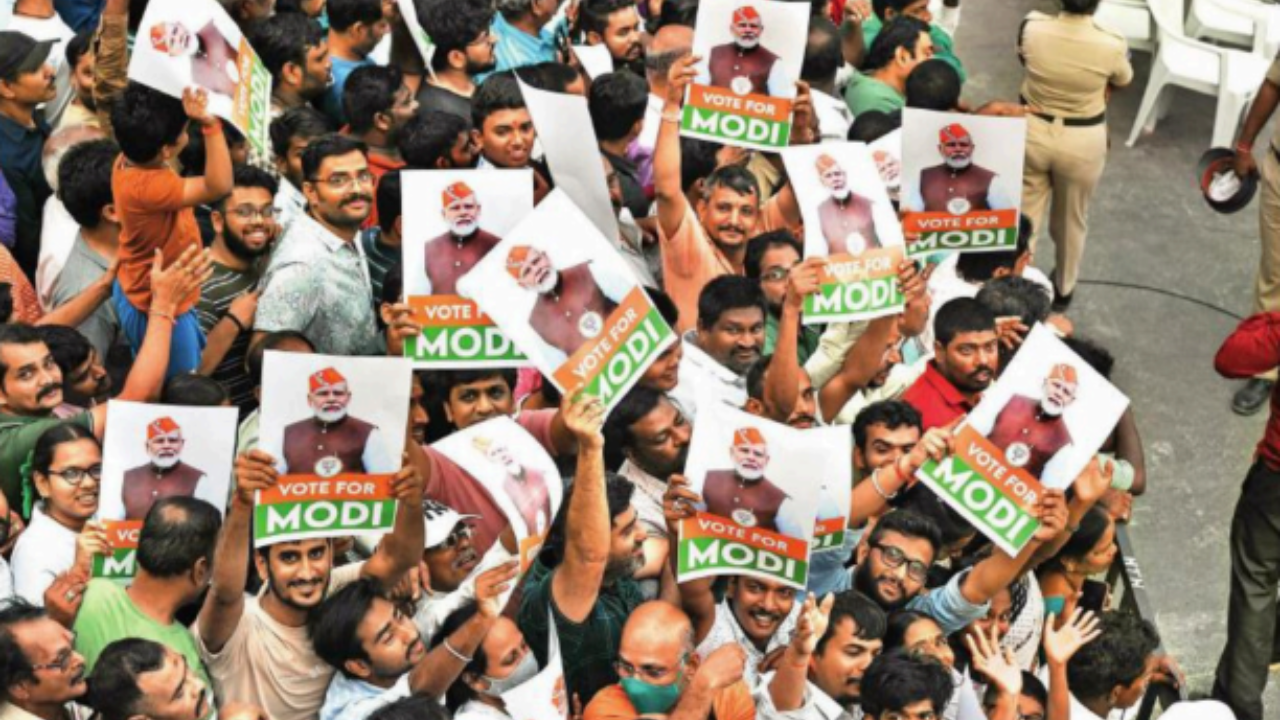
BJP’s big push in Telangana, with a little help from a troubled past | India News
[ad_1]
There is, of course, no guarantee that BJP will increase its tally of four of the 17 seats won in 2019.Poll pundits are predicting different numbers for BJP but they are unanimous that Telangana’s voters appear more amenable to BJP’s brand of politics than other southern states.
While Modi is very popular in the state, especially in urban areas, the Telangana BJP will have to contend with deep internal fissures. Of the 17 candidates the party has fielded, only a handful are old Sangh hands; most are recent imports from other parties. This has left some core BJP men upset.
But the sentiment that BJP needs for its growth here still has some momentum.
The first key ingredient that BJP is hoping to cash in on is the region’s turbulent past — the politics around the last Nizam of erstwhile Hyderabad state, Mir Osman Ali Khan, and his reluctance to join the Indian union.
Although a largely secular figure as a ruler, the Nizam was unable to control his private militia, the Razakars.
“Both the Left (Telangana had a strong communist presence in the 1940s) and the Right wing had fought against the Nizam and his private army, immediately after Independence. BJP methodically developed a narrative to present the fight against the Nizam as one by Hindus against Muslim rulers. During his recent tenure as BJP state chief, Bandi Sanjay could reach out to the youth with his rhetoric,” said K Sreenivasulu, retired head of the political science department at Osmania University.
To cement its anti-Nizam identity, the Union ministry of home affairs announced that Hyderabad Liberation Day will be celebrated every year on September 17 to remember the martyrs who liberated Hyderabad on this day. This was the day when the Indian armed forces had entered Hyderabad in 1948 as part of Operation Polo and forcibly merged it into India. BJP has been accusing BRS of not celebrating the day all these years just to please AIMIM.
It is also not as if BJP has emerged out of nowhere in Telangana. The party’s graph has seen a gradual upward swing albeit with many ups and downs. In the first assembly election after the state was formed in 2014, the party, which was in alliance with TDP at the time, gained five seats. In 2018, the partnership fell apart and Raja Singh from Goshamahal was the only BJP legislator in the assembly.
Within a few months, BJP stunned everyone by winning four seats in the 2019 Lok Sabha election. Even then chief minister K Chandrashekhar Rao’s daughter K Kavitha lost to a BJP newbie, D Aravind, in Nizamabad.
In the 2023 assembly elections BJP won eight seats, its highest since 2014, but way below the expectations of the high command. But the party’s vote percentage has been constantly increasing from 10.5% in 2014 to 19.45% in the 2019 Lok Sabha elections. The party again shocked everyone in the 2020 Greater Hyderabad Municipal Corporation election, increasing its tally from just four seats to 48 seats and emerging as the second biggest player after BRS with a 35% vote share. Its numbers again dipped to 14% in the 2023 assembly election, but the leaders are hoping that Modi’s popularity will help them end this rollercoaster ride in the May 13 elections.
H Vageeshan, assistant professor of political science at NALSAR Uni versity of Law in Hyderabad, ascribed the BJP’s slow but steady rise to deeper historical factors related to RSS’s operations. According to him, Arya Samaj was strong in Telangana’s border districts with Maharashtra and Karnataka. “When Arya Samaj’s influence gradually weakened, RSS was able to make inroads, particularly in district headquarters, and gain support from people opposed to the Left-wing ideology in North Telangana (districts like Warangal, Nizamabad and Karimnagar). This significant activity began in the 1960s, and the first indication of urban penetration was apparent when an RSS leader, Janga Reddy, won the Hanumakonda LS seat as a BJP candidate in 1984.”
K Laxman, BJP national parliamentary board member and national OBC Morcha chairman, claims that their caste and social engineering is effective in a state with 52% backward classes, 18% Dalits, and roughly 9% minorities. “BRS and Congress failed to accommodate backward classes in their governance, whereas TDP did to some extent in united Andhra Pradesh,” he says. “PM Modi is the biggest backward class face. We accorded legal status with the national BC commission, and BCs in Telangana see the BJP as the best bet after BRS’s decline.”
Leaders argue that the lack of multiple regional parties in Telangana, unlike in Tamil Nadu (AIADMK, DMK) and Andhra Pradesh (TDP, YSRCP, and Jana Sena), makes it easier for them. Following Andhra Pradesh’s bifurcation, BRS took advantage of the vacuum left by TDP, as many leaders, cadre, and voters migrated to BRS (BRS chief K Chandrasekhar Rao left the TDP to found BRS then TRS).
“With BRS dwindling in popularity and losing the 2023 assembly elections, it is obvious that the TDP vote bank converted to BRS would switch to BJP, and it will be an easy transition of votes; it will happen quickly and is already happening,” Kishore Poreddy, a BJP spokesperson, said.
[ad_2]
Source link
